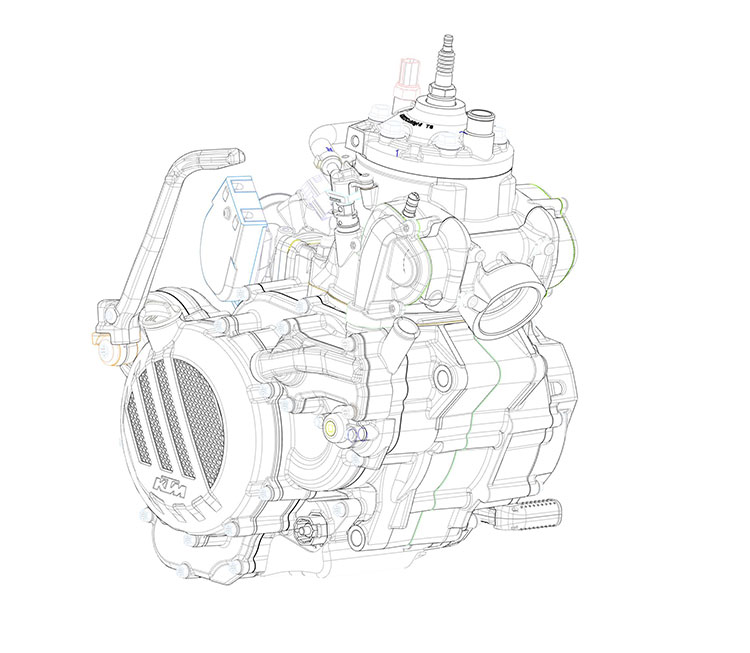 KTM’s announcement of a fuel injected two-stroke should not be a surprise. It has been hinted at by the R&D teams at other press launches, prototypes have been seen at races and the pending emissions regulations in Europe are pressing the issue. For sure there was no way KTM was going to lose the 250/300 engine, the companies largest selling platform, to a regulation that was really not that far off. At least in Europe they have not had an outright ban on engines called two-stroke, like we have had in the US. Or that is the way it has been perceived.
KTM’s announcement of a fuel injected two-stroke should not be a surprise. It has been hinted at by the R&D teams at other press launches, prototypes have been seen at races and the pending emissions regulations in Europe are pressing the issue. For sure there was no way KTM was going to lose the 250/300 engine, the companies largest selling platform, to a regulation that was really not that far off. At least in Europe they have not had an outright ban on engines called two-stroke, like we have had in the US. Or that is the way it has been perceived.
Click here for the Riding Impression
The FI two-stroke info was delivered to the press through an invitation to the launch of the 250 and 300 EXC (in Europe) and the 250XC-W in the USA. The info is somewhat reveling but there is a lot more.
KTM says there will be, “considerable benefits over carbureted models including drastically reduced fuel consumption while also no-longer having the need to pre-mix fuel or alter the machines’ jetting.”
Called TPI (Transfer Port Injection) the biggest difference from current off-road four-stroke fuel injection systems is the placement of the injectors in the transfer ports and not in the throttle body or in the air boot (from what we can see). The line drawings give some things away but we asked a lot of questions to get a better understanding of what the revolutionary part of the equation is.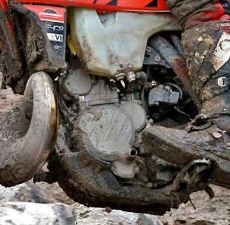
The toughest thing for a two-stroke in the Euro 4 standard is the cold start up emissions. But a lean setting in a two-stroke and the need for lubrication present some challenges. There can’t be the pooling of fuel and oil to cause a sudden surge of bad stuff coming out of the tail pipe. And lean is horrible for power–no way KTM will release a softer version of this bike under the “ready to race” slogan. Luckily KTM cleared up the name or some of the rocket scientists that pose as moto journalists would be calling it direct injection, which it is clearly not.
Some sources have said there are actually four injectors on this bike. The line art shows two clearly mounted on the side transfer ports of the cylinder. We know that the oil will be electronically distributed to the engine as well by the comment for not needing to mix the fuel. This technology is not new and is available on Beta’s now. There is a tube on top of the reed block that could ideally be the position for this oil to flow. Some more advanced designs would have the oil flowing in through the crank center to the big end of the rod but that is complex. Keeping the two-stroke simple has been one of KTM’s main objectives. So why not mix the oil and gas before injection? 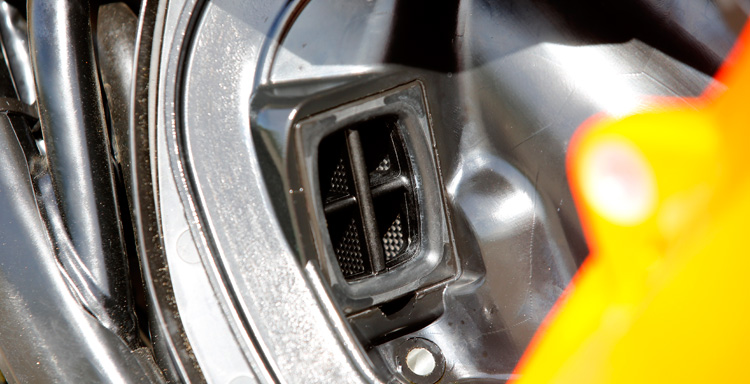
If there are two more injectors or if the oil injector is indeed one, is there an upstream injector in the mix too? Like on some four-stroke dirt bikes the placement of an injector in the air boot can aid high-RPM power. There is not one mounted in the throttle body from what we can tell. And having a third fuel injector that could be used to make power when needed and not be in play when cleanliness is needed could solve some problems. Here some of KTM’s other technologies like the Velocity Focused Intake (reed valves in the air boot) could come into play and be utilized.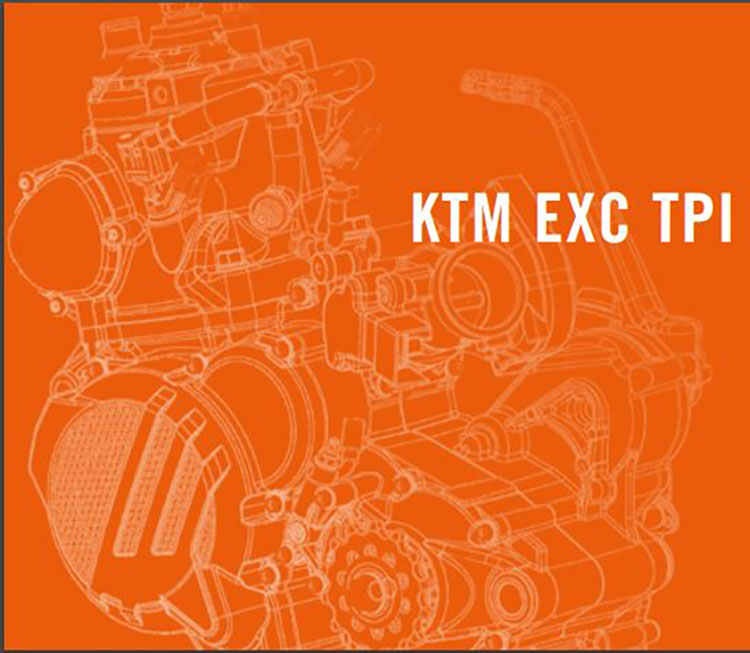
The orange line art also shows a tube going into the engine above the reed block. This is the likely place for oil injection but dripping it into “dry air” is not really the cleanest thing. A big part of two-stroke FI is knowing what the engine is doing and it is a little more active than a four stroke. As well as happening twice as fast. Knowing the pressure inside the crank case would be very beneficial to the ECU in addition to the pressure in the intake in front of the reed valve. Add to that the regular coolant temp, throttle position, crank position and air temperature this all makes metering the proper fuel delivery easier. Since the system is claimed to be supplied by Mukini, a company that has been largely out of the off-road motorcycle four-stroke game since the Italian built Husqvarnas went away. This may have given them time to work on a revised system for two-stroke. Patent search has revealed that Mukini holds a number of vital patents for two-stroke based fuel injection going back into the 1970’s including some that are related to the crankcase or engine pressure sensing that is so important.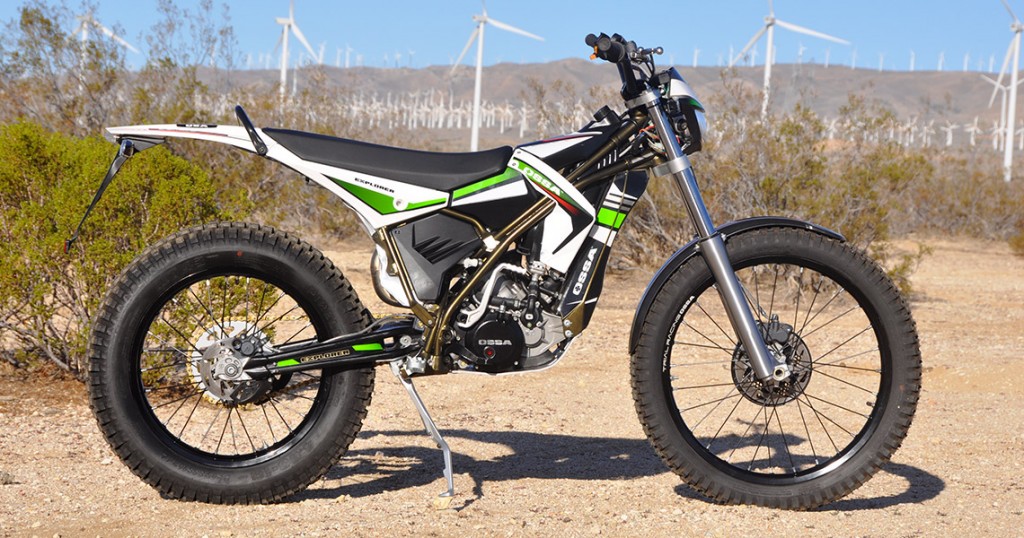
Remember that two-stroke FI has been used by Ossa just recently. It was a simple throttle body based system that actually performed quite well in its application, even if very hard to start. Honda had a stint with technology called ARC (active radical combustion) in the 1990s where they controlled the combustion chamber burn at low RPMs with the powervalve, even though it was using a carb and mechanical oil injection. We have also been told that TM, Beta, Sherco and Gas Gas are all deep into development of two-stroke FI systems. TM claims a 2018 FI two-stroke will be seen at the Milan show and released in calendar 2018. Sherco even had videos (now deleted) of their two-stroke FI bike being tested. Since then the company has taken a step back to continue development after likely running into complications with patents and the difficulty of proper two-stroke FI. Cost will play an issue and until production numbers of special parts till a big player like KTM changes the game.
So what are the benefits? Besides being mandated to be clean at the tailpipe the biggest gain in efficiency will be in the loss a carburetor has through the venting system, a typical 10 to 15% gain in efficiency at a minimum. FI will increase the length and rideability of the power delivery and increase the range of throttle openings the bike will take without bogging. Outright power might not be the first thing on the list, but as the technology expands, the power will increase. Likely with advances in the powervalve and exhaust controls that two-strokes rely so heavily on. But then the two-stroke will become as complex, if not moreso than a four-stroke.
KTM says the bikes will be available in early summer in the EU (250/300 EXC) and later in the fall in a very limited run in the US as a 250 XC-W. Prices have not been set but expect a $1000 increase over current pricing.


2 Responses to “KTM FI Two-Stroke Info: The Scoop on TPI (Transfer Port Injection)”
Daniel Girald
It’s obviously quite surprising that KTM didn’t resort to a direct-injection setup, since it’s been well-proven in other applications such as outboards and snowmobiles, but this transfer-port injection seems to address quite well the NOx issue that plagues direct-injection engines.
Jimmy Lewis
They really tried and we will have a tech article about this very soon…